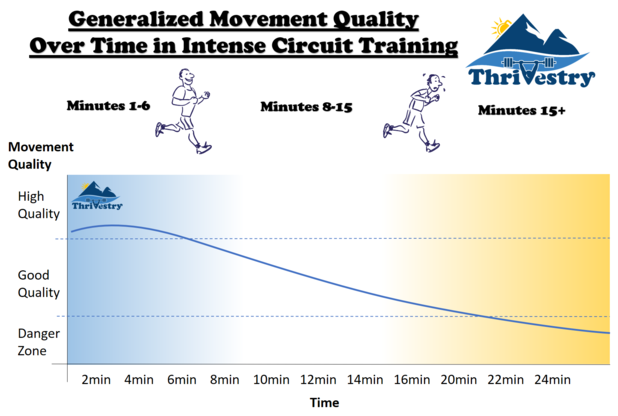My post last week about class structures that fostered human connection spurred some great discussions and I thought these questions from Craig K. were particularly insightful.
The longer workout debate with clients will always be an issue as long as the prevailing wisdom is ‘longer is better’ and ‘no pain, no gain.’ (Read more about “Exersubmissives” here). Hopefully some of the stuff I talk about below will help arm you all as coaches as you encounter this, and help clients get the most out of their class time according to their goals and expectations.

And here is a graph that you can use (or draw on a whiteboard) to help explain movement quality vs time.
From Craig:
“…I just wanted your opinion: as you eluded to in the post, and as coaches for life with the goal of having our clients thrive until old age, not training for specific sport performance, our main goal isn't results ONLY but creating an experience the client enjoys. If a client prefers the feeling of a 12-14 min workout over a 6-7min workout, even if the 6min one is more effective at giving them results, is it worth a discussion that it could be more beneficial to slightly increase the overall volume without going into an amount that is harmful vs keeping it short and explaining to the clients why they don't know what they want that this way is better for them…
… I was wondering how you settled on 6-7min vs. 10-12 min for a "short" workout. I am not the guy that programs chipper and countless slogfest day in and day out, I thought I had a good mix of strength, short, Med and long wods before. It just seemed that my "short" wods were rarely less than 8min especially for my general population CrossFitters…”
My Response:
These are great questions!
The 'magical' 7 min that seems to dominate comes from a bunch of factors metabolically and training effect wise, but some of the reasons are 'functional'.
When we are taking time warm up, practice a skill, lift, teach the movements, set up, etc. There just isn't enough time to do 10+ minute workouts in the hour! It tends to cut into instruction and interaction time.
More time spent on instruction and practice means more quality reps. You can explain it this way: If they were to do a 3 round workout with lots of healthy practice and technique work, they are actually doing a similar amount of volume as the 5 round version without it - but in the former example the amount of really good reps will be much higher than what they would do as they start to break down on rounds 4 and 5!
You will also notice that I rarely (if ever) post a workout that is less than 10 minutes unless we are doing a lift that day.
When clients are asking for more 'long' workouts, generally it can be a multitude of things (a misunderstanding of how to get results, a desire to 'punish' themselves, a feeling like they want to do 'more' that day, an addiction to endorphins, etc.).
The best way to combat this is through education and the application of the programming itself. For the application part:
· Make sure they are getting thoroughly 'hot' during the warm up. Sweating and layers coming off before class even starts if possible.
· Push these individuals during the group warm up parts and don't let them slack off during the mobility and skill portions. Make them do a ton of reps when doing skill work and warm up sets on lifting days.
· Before the metcons start (on lifting and non lifting days), make them demonstrate and practice the movements multiple times before the call of "3, 2, 1, GO!".
· During the 'short' metcons (and long metcons I guess), point out to them how much they are standing around and resting/getting chalk/getting water. Give them a bit of good-natured ribbing about how they must always want to do longer workouts so they can do more standing around with the music loud.
· Teach them about the cash outs and have them get set up before the workout. Have them do the metcon, then rest 1-2 minutes and then do the cash out right away.
It is okay for some people to want the longer metcons, but if they are sweating and moving the entire hour, they should feel satisfied when they leave.
The art to this is to not make everyone do this in every class. Some people will dislike this pace and how it negatively affects their lifting and metcon performances (because the extra volume tires them out). Coaches should learn who wants the extra push, and who likes the other aspects (the social, the performance, etc.).
Hope that answer's your questions!
-jj
If you are a gym owner and you want more content like this, as well as programming for your community that you can be proud of and that will free up your time - click here to get one of our programs.
